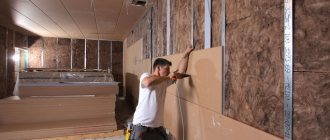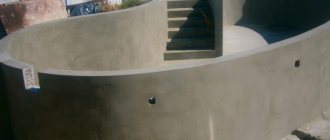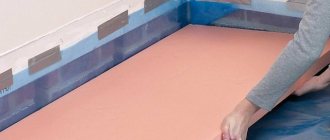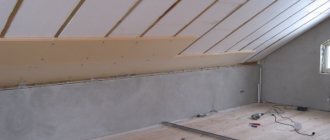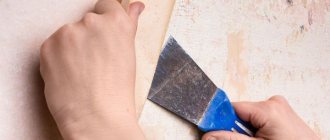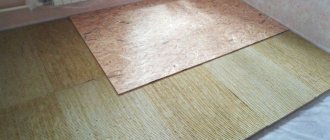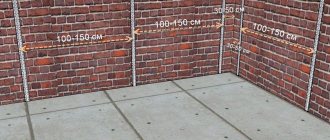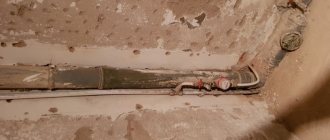Characteristics and properties of the material
This is extruded polystyrene foam. The composition is balls filled with air that dampen sound vibrations. Application is the temperature regime of the room.
Negative and positive properties of the material:
- sound insulation indicators - 23-41 dB - a good indicator;
- thermal conductivity coefficient 0.031-0.032 W/(Mx0K) – practically does not allow heat to pass through;
- water absorption per day 0.4% - does not absorb moisture;
- tensile strength in bending 0.25-04 MPa - durable material;
- fire resistance category G3.4 – low flammable;
- easy installation of material;
- shelf life is 20-50 years, depending on the installation location and the factors influencing it;
- not subject to aggressive environments - many building materials do not destroy the structure of penoplex.
Disadvantage: installation at height. It is required to invite a team of craftsmen with equipment.
Types of foam
The construction industry offers a significant range of products in this class. Foam grades reflect its origin and characteristics. There are two types of material. Pressed and non-pressed. It is not difficult to distinguish from. The first is a single porous body, and the second is produced by sintering ready-made granules, which is clearly visible visually. For sound insulation, preference is given to non-pressed soft foam. It effectively dampens vibrations and is easy to process.
In construction, the most popular types are the following, which indicate the following foam markings:
- PSB. Pressless foam plastic of several modifications. The last digit in the abbreviation means the strength class. For example, PSB-S-50 is the most durable material in this category. Used where mechanical strength is required. PSB-S-25 is a universal material widely used in construction for many purposes. The softest product is PSB-S-15. Due to excessive fragility and fragility, it is rarely used. It can become attractive solely because of its low price. If the letter F appears in the name, this means that the product can be used in facade work.
- PPU. Foamed mass based on polyurethane. One of the modifications is foam rubber. The material is elastic and very convenient to use, but its cost is quite high. For this reason it is used in limited quantities.
- PPE. The polyethylene base provides elasticity and wear resistance. This marking can be found in hardware stores on many products, but is rarely used for sound insulation.
- PVC. Polyvinyl chloride foam. It is distinguished by the absence of substances harmful to health. The environmental friendliness of the material, which manifests itself under normal operating conditions, is attractive, but danger arises during combustion. Exceeding the critical temperature leads to the destruction of structural bonds and the release of extremely dangerous hydrogen chloride, which, in combination with the liquid, begins to release hydrochloric acid. For the respiratory tract, the smoke emitted by PVC foam is very dangerous.
The most popular and widespread type of polystyrene foam is considered to be the material labeled PSB. Excellent performance combined with an affordable price make it attractive in all respects.
Will it help to soundproof walls and ceilings?
Initially, expanded polystyrene was used for repairs and foundation construction.
The base of the building was protected from moisture and freezing. Afterwards, penoplex began to be installed as insulation for building facades, balconies, and attics. Now the material is also used as a sound-absorbing material, due to its characteristics.
Scope of application of the material:
- Insulation of dachas and country houses, cottages.
- Insulation of balconies and soundproofing of apartments.
- Application in factories and hotels, churches.
Sound insulation is produced by various methods using different materials. Penoplex has good characteristics for creating silence in the room.
Installation features
At the installation stage, the future characteristics of the soundproofing layer are laid down. The installation method is a key factor. Sound insulation will be satisfactory if there is an understanding of the processes taking place. This will allow you to most effectively protect your home from extraneous sounds and avoid mistakes.
To do this, it is necessary to consider all installation methods with an assessment of the final result:
- Fixation with glue. Convenient, economical and most effective installation method. If foam plastic is glued to concrete, brick, plaster, then the most complete fit is ensured. Vibrations in this case are damped well. Do not use adhesives
- Installation of foam plastic with fasteners. The method is good for external use. Often used for insulation and soundproofing of walls.
Inserting into the cells of the sheathing. A large number of individual elements creates risks for complete shelter. It is difficult to avoid gaps and cracks. Rigid metal profiles that transmit vibrations well also do not contribute to good sound insulation.
How to finish walls and ceilings yourself
In order for the room to be warm and quiet, it is necessary to make sound insulation with polystyrene foam 3-4 cm thick. If these are load-bearing walls facing the street, the thickness must be increased to 15 cm. Also, the silence in the room depends on the material of the walls - brick, concrete, slab.
To finish yourself with penoplex, you need to perform a series of steps in stages.
What you need
Before you start, you will need the following tools:
- construction knife and set of blades;
- container for adhesive solution and construction mixer;
- perforator;
- level;
- hammer.
Materials you need to purchase:
- dowel-nails;
- penoplex;
- adhesive mixture for laying tiles;
- primer;
- polyurethane foam;
- fasteners (fungi).
After the material is prepared and the tools are assembled, work begins.
Work progress
Installation of material on the ceiling. This is done if you need to protect the room from sounds from above. The material is attached to the ceiling using an adhesive solution.
- Clean the surface from dust, whitewash, and previous coating. Cover with primer.
- Using a mixer, mix the solution.
- Glue the slabs to the ceiling. To do this, glue is applied in a thin continuous layer to the entire surface of the penoplex.
- The slabs are secured on top with self-tapping screws. Each is secured at the corners with screws for strong fixation.
- After the adhesive solution has dried, the joints are sealed with foam.
- After 24 hours, excess foam is cut off. Apply a layer of plaster according to the rules.
- After drying, the surface is puttied.
- After the next layer has dried, the ceiling is coated with a primer and the finishing coat is applied.
The final coating is painting, wallpapering, and decorative plaster.
Work procedure for soundproofing walls:
- Preparatory process. The walls are cleaned (dust, cobwebs, old coatings) and primed.
If the walls are damp, dry them. Only after this they prime.
- Mix the adhesive solution in a clean container according to the instructions on the package.
- Each slab is fixed to the wall using an adhesive solution and fasteners.
- After the glue has dried, the joints between the plates are filled with foam.
After the foam has hardened, the excess is cut off. The surface is covered with plaster and putty.
For plastering, fiberglass should be used.
Finishing
After the adhesive solution and polyurethane foam have dried, the surface is plastered and puttied.
Plastering work consists of the following stages:
- Preparation;
- reinforcement;
- applying layers.
Each step is important for a strong and level surface.
The preparatory process includes preparing tools and purchasing the necessary materials:
- Plaster. You can purchase a gypsum-based mixture, but there are compositions for polystyrene foam.
- Deep penetration primer.
- Reinforcing fiberglass mesh.
- Spatulas with different blade widths.
- Metal corners.
You need to inspect the surface. If necessary, trim the foam to make the surface even.
The next stage is reinforcement.
Fixing the mesh is an important stage of work. If the reinforcement is done incorrectly, the plaster may crack and fall off. To attach the mesh, a layer of plaster mixture up to 3 mm thick will be applied to the penoplex. The mesh is applied to the wet layer in such a way that there are no folds and at the same time it is not too tight. After application, it must be pressed into the mixture. A spatula is used for this.
Direct application of plaster. For this you need a beacon profile. It is fixed to the solution. The distance between the beacons is 1 m. Plastering the surface requires skills and knowledge.
After the plaster layer has dried, the surface is treated with a primer. This is necessary for better adhesion to the surface.
Plaster and putty must have the same base, for example, gypsum.
The layer of putty applied should not exceed 2 mm. After drying, grouting and priming are carried out.
Wallpaper is glued onto such a surface, painted, tiled, liquid wallpaper and decorative plaster are applied.
How to avoid mistakes when working with Penoplex
Experienced craftsmen advise adhering to the following recommendations in order to obtain a good sound and heat insulation effect:
- Before you begin soundproofing, you should assess the noise level and identify noise “bridges” in order to pay special attention to them during installation.
- When insulating walls, the slabs are laid in rows, starting at the bottom and moving up.
- To improve the adhesion of the slab to the base, it is necessary to walk over the surface of the Penoplex with a toothed roller or rub it with sandpaper.
- If the slabs are fastened with dowels, it is necessary to carefully calculate the length of the nail. To do this, it is necessary to add the actual difference in the surface of the fastener to the thickness of the plate and glue and add 2 cm to the depth of the hole for the dowel.
- The dowel attachment points should be staggered relative to each other.
- To strengthen the surface of Penoplex, a reinforced fiberglass mesh is attached to the slabs. It is applied to a layer of glue and leveled with a spatula until it is completely immersed in the glue.
- When foaming the joints between the slabs, gaps should not be made, otherwise the insulation effect will be minimal.
- Manufacturers offer several types of slabs, varying in thickness and characteristics. It is necessary to choose the modification that is best suited for a particular type of work.
Noise insulation with polystyrene foam: disadvantages of the method
To list the disadvantages of the penoplex soundproofing method, it is necessary to clarify the disadvantages of the material.
The main drawback of the master is considered to be the percentage of fire. In a fire, penoplex emits toxic smoke.
Penoplex is not used as a soundproofing material in wooden houses and buildings. The material cannot remove moisture from a wooden structure. Subsequently, a fungus appears on the tree; the tree does not “breathe.”
Penoplex sound insulation dampens impact noise worse. These are repair and restoration work, construction. A smaller percentage of sound suppression from neighbors is a minus.
And also a minus - it requires skill and time.
Penoplex is a unique building material that combines several functions:
- thermal insulation – saving on electricity, heating costs;
- sound insulation – comfortable rest after a working day;
- smooth surface - even when carrying out plastering and puttying work, there is no need to waste time on leveling.
The disadvantages of the material are minor; during installation, the craftsmen do not mention fire safety or do not emphasize that penoplex will make the room completely quiet.
Soundproofing measures
It is required to take a comprehensive approach to reducing noise in an apartment, following certain rules for performing the soundproofing procedure. Several sequential actions must be taken:
- To soundproof floors, it is recommended to use extruded polystyrene foam with a certain compressive strength, since this surface will be constantly subject to intense loads and mechanical stress.
- There are several ways to soundproof walls. This procedure can be carried out indoors or outdoors.
- Ceiling insulation through the use of insulation boards is used when it is impossible to install a suspended version.
Penoplex is great for sound protection. The consumer has the opportunity to purchase material of various thicknesses. Penoplex can be securely fastened to insulated surfaces and is characterized by high strength and resistance to mechanical stress, thanks to which it can withstand a load of 400 kilograms. This property makes this sound-proofing material indispensable in floor finishing.
Sound insulation of walls
The use of penoplex in soundproofing walls is combined with thermal insulation. As for the external method, the walls are faced with a ventilated facade. In this case, it is better to entrust the work to specialists. You can make internal insulation yourself. It is carried out in several stages:
- material is cut;
- walls are marked for installation of slabs;
- using an adhesive solution, foam boards are glued;
- disc dowels are used to secure the slabs;
- Aluminum tape is applied at the junction of the plates; polyurethane foam can also be used here;
- the surface of the slabs must be plastered;
- final finishing work of the walls.
Soundproofing the floor
If you plan to install penoplex in an old apartment, you will need to open up the old wooden floor and dismantle the joists. If your apartment is located on the ground floor, then under the floor there is probably an insulating pad made of glass wool, which also needs to be removed. Only after these preparatory works can you begin laying soundproofing material.
The stages of the work are as follows:
- prepare the surface and material;
- we mount the frame so that the cells have the same size as the slab;
- we install slabs;
- seal the joints;
- We install plywood or another base on the surface of the frame;
- We install the finishing flooring on the floor.
Installation of penoplex on the ceiling
Soundproofing the ceiling may be required if neighbors upstairs annoy you with their stomping. Since there is no load on the ceiling that is typical for the floor, the material can be glued. Work order:
- you need to clean the ceiling from the old coating and prime it well;
- we attach the plates to the adhesive solution and secure them with dowels;
- joints must be sealed using polyurethane foam;
- apply a layer of plaster and wait for it to dry;
- The ceiling is puttyed and the finishing coat is applied.
Using the soundproofing material in question, you can achieve the desired result. Penoplex is an inexpensive material, thanks to which you can not only prevent extraneous sounds from entering your apartment, but also prevent neighbors from eavesdropping on your personal life.
To learn what material is best to use for sound insulation, see the video below.
What kind of noise is there?
What noise can be heard in the apartment? Most often, a peaceful rest at home is disturbed by external and internal noise. External noise includes sounds coming from the street: cars passing nearby, children walking in the yard, barking dogs, loud conversations of passers-by. Installing high-quality double-glazed windows on your windows will help you cope with these types of noise.
The situation with indoor noise is more complicated. These include directly: the sounds of a moving elevator, slamming entrance doors, voices heard on the landing - as well as intra-apartment and intra-room sounds. They represent noise from the movement of neighbors: slamming doors in an adjacent apartment, stomping feet, loud conversations or loud TV sound.
You can combat the latest types of noise using soundproofing of the reproductive system. The very design of multi-storey buildings contributes to the spread of sounds between apartments. All the walls and ceilings of the house are interconnected, so they transmit sounds between apartments quite quickly. This type of noise is called structural noise, since shock vibrations are transmitted from one part of the building to another.
General soundproofing scheme for a wooden floor.
Structural noise can be successfully dealt with: it is almost impossible to get rid of it completely, but it is quite possible to drown it out as much as possible. Why is floor soundproofing so important? The floor in an apartment in a multi-storey building is a concrete covering or wooden flooring - a horizontal surface that perfectly distributes extraneous sounds. By soundproofing your floor, you can forget about most extraneous sounds.
Summary
The affordable price and good technical characteristics of expanded polystyrene provide a wide range of its applications. It is most necessary in construction for insulation and sound insulation:
- loggias, verandas, balconies;
- pipelines;
- flat roofs, inversion (with reverse order of layers) roofing;
- foundations, basements, ground floors;
- interfloor ceilings, floors - and it is allowed to lay polystyrene foam directly on the ground;
- pitched roofs, attics and attics;
- facades, interior walls.
Extruded slabs are laid during the construction of airports, roads and railways, and the arrangement of drainage systems. They eliminate the occurrence of deformations associated with soil freezing. Also, according to user reviews, polystyrene foam produced by extrusion is necessary in beekeeping (for making hives), in agriculture (insulation of various objects, the root system of young plants), and as containers. In the future, it will be needed as a furniture board, an integral part of sandwich panels.
Opinions about the dangers of extruded polystyrene foam are controversial; most experts believe that if the production technology is followed, the impact on human and pet health is minimal and cannot lead to negative consequences. But some continue to argue that during the initial period of operation of extruded blocks, a dangerous monomer, styrene, is released. The latter belongs to slightly toxic substances of hazard class 2 and causes irritation of mucous membranes.
Polystyrene foam produced by extrusion is more harmful during combustion, when it emits acrid smoke. But the options offered on the market are mainly classified as class G4, that is, the cause of fire is an open flame (for example, a blowtorch, match), or a gas welding spark. Expanded polystyrene will not ignite from a thrown cigarette butt or hot metal
Its important characteristic is the impossibility of maintaining the combustion process - if the source is eliminated, polystyrene foam will quickly extinguish. To enhance this ability during production, it is impregnated with fire retardants.
Expenses
The cost of extruded polystyrene foam depends on its thickness, density, and size. It differs from one manufacturer to another. Typically, insulation is specially packaged to facilitate transportation and protect against external factors. Based on the main characteristics (dimensions, density), a different number of sheets are supplied, which is why the price per m2 or m3 is often indicated. Shipping should also be taken into account to calculate final costs. According to reviews, if the work on insulation with polystyrene foam is not carried out independently, this increases the cost by another 20%.
| Name | Dimensions of extruded plates, cm | Packaged | Price, rubles per | |||
| Area, m2 | volume, m3 | set | m2 | m3 | ||
| Penoplex foundation | 120x60x5 | 5,76 | 0,288 | 1250 – 1490 | 230 – 260 | 4250 – 5200 |
| Teplex 35 | 1100 – 1200 | 200 – 210 | 4000 – 4100 | |||
| TechnoNIKOL XPS 30-250 Standard | 118x58x5 | 5,48 | 0,274 | 1110 – 1230 | 200 – 220 | 4050 – 4490 |
| Ursa XPS N-III-L | 125x60x5 | 6 | 0,3 | 1150 – 1200 | 190 – 200 | 3850 – 3980 |
| Styrofoam IB 250-A | 125x60x10 | 3 | 0,3 | 1530 – 1570 | 510 – 530 | 5100 – 5250 |
| Ravatherm XPS ECO G4 | 120x60x5 | 4,159 | 0,208 | 790 – 850 | 190 – 210 | 3800 – 3900 |
Classic technologies
Extruded polystyrene foam - properties and technical characteristics
There are a lot of fairly simple and quite affordable ways to equip high-quality soundproofing of the ceiling in an apartment. Get rid of annoying screams, stomping and noise from upstairs neighbors once and for all. Equip your ceiling with reliable sound-absorbing materials, and you will be surprised how much calmer you will live in your apartment. For this purpose, you can use any of the many possible materials. Fortunately, today there are dozens (if not hundreds) of such options. Modern technologies in the field of construction and engineering offer us the latest substances and innovative techniques. However, the following traditional materials still remain the most popular.
Styrofoam
This is perhaps the most popular and widely used method, having been extremely popular for many years and receiving only positive reviews. Polyfoam is quite affordable and easy to use, in addition, it has excellent sound insulation properties. Watch the video carefully and you can get acquainted in more detail with the process of insulating the ceiling using polystyrene foam.
Mineral wool
This method is perhaps almost as popular as the technology based on the use of foam plastic. You can install this design yourself. The main advantage of mineral wool is its amazing soundproofing abilities and excellent noise absorption properties. This method has one drawback - the thickness of the entire structure, which includes insulation, will be quite significant (up to fifteen centimeters), which will significantly reduce the height of the ceiling. However, reviews of such installations are mostly positive, which is explained by the excellent quality of sound insulation.
In addition to these common classic materials, there are more modern and relevant methods for isolating sound waves. Let's talk about them in more detail.
Common Methods
The most relevant and effective method of sound insulation today is to cover the ceiling with plasterboard on top of special sound-absorbing modern materials.
Quite often there is also a method that is based on the installation of special acoustic suspension systems. In this case, polyurethane blocks, cork, basalt wool, etc. can act as soundproofing agents.
Do not forget that soundproofing a ceiling traditionally involves all sorts of accompanying work. One of the main tasks is the installation of an auxiliary structure. These can be the following types of systems:
- Tensile structures. In this case, special parts are attached directly to the surface, onto which fabric or other coverings are attached.
- Hemming systems. The metal frame is covered with sheets of plasterboard.
- Suspended structures. Soundproofing boards are suspended from the ceiling surface.
In all these cases, the use of special insulating substances is required (today you have a huge choice). All cracks, cracks, gaps and holes must be securely sealed with such materials. Only then will you be able to provide yourself with high-quality, effective and long-term sound insulation, which will give you a feeling of calm and confidence.
Don't tolerate annoying sounds coming from above. If you are familiar with this problem, you can ask your neighbors to install soundproofing flooring in their home. However, if you fail to come to an agreement with them, do not be discouraged. Having carried out competent, high-quality and reliable sound insulation of the ceiling, you will forget about this problem once and for all. And from now on, you will always be in a good mood and will be able to properly rest and relax when you return home from work in the evening.
